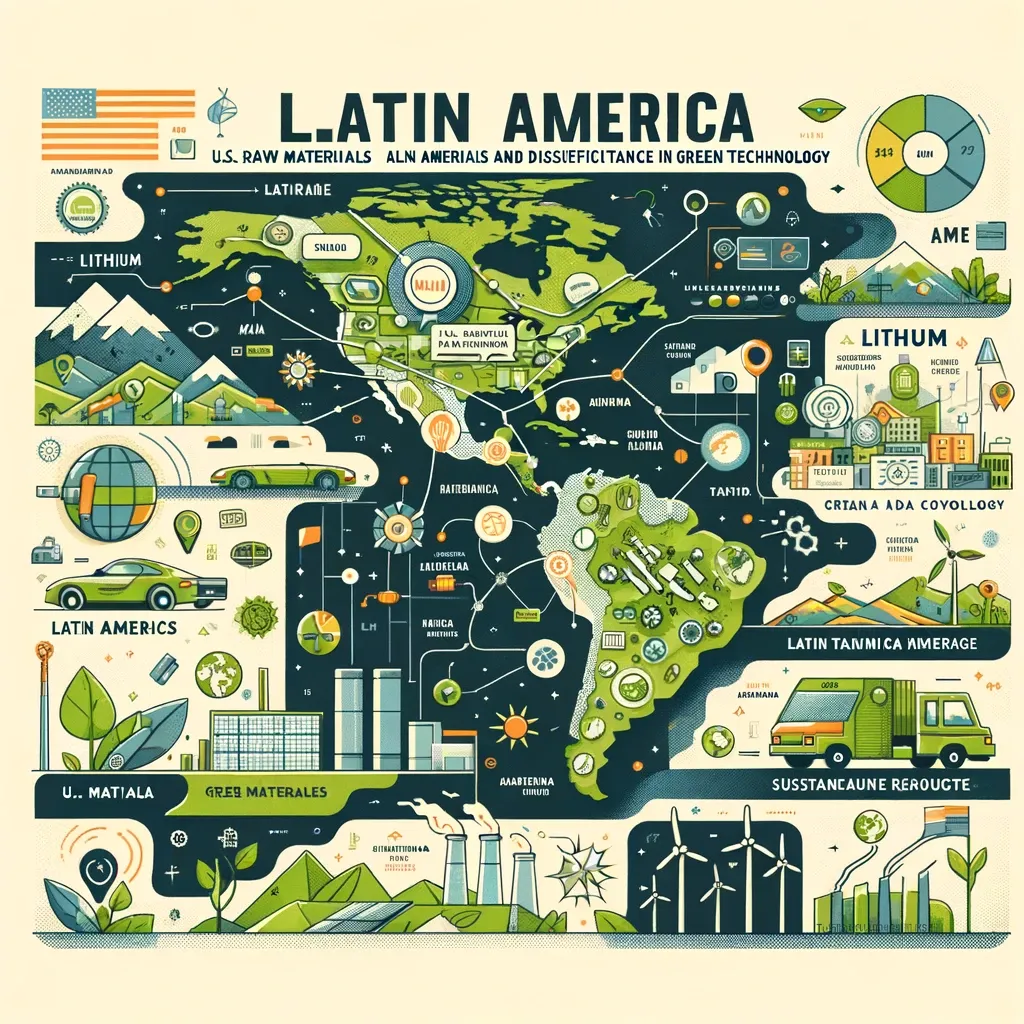Ecuador's Renewable Revolution: Pioneering Sustainability and Prosperity
Discover how Ecuador's unique geography positions it as a leading player in sustainable energy through geothermal and solar resources, driving U.S.-LATAM economic growth and curbing illegal immigration.
- Ecuador's unique geothermal and solar resources present an opportunity for sustainable energy and economic growth.
- Development of these resources can create jobs locally and in partnership with U.S. companies.
- This green energy initiative can reduce illegal immigration by improving economic prospects in Latin America.

"Ecuador's Green Gold" Metaphorical representation. It artistically depicts Ecuador as a treasure map, highlighting its renewable energy resources as valuable treasures.
Introduction
Ecuador stands on the cusp of a renewable energy revolution, with its vast geothermal and solar resources offering a pathway to sustainable economic growth and stronger U.S.-LATAM partnerships. This blog delves into how Ecuador's strategic embrace of its "Green Gold" can stimulate job creation, foster energy independence, and contribute to regional stability.
The Power of Geothermal and Solar Energy in Ecuador
Nestled along the equator, Ecuador's landscape is ripe for renewable energy production. The country's active volcanoes and consistent sunlight present untapped opportunities for geothermal and solar energy, promising a cleaner, more sustainable future. These renewable resources are not just environmentally beneficial but are also key to unlocking economic growth and reducing reliance on fossil fuels.
The Geothermal Advantage
Ecuador's volcanic terrain harbors immense geothermal potential. By tapping into the Earth's heat, Ecuador can generate reliable, low-carbon energy, creating a wealth of job opportunities and setting a precedent for renewable energy utilization in Latin America.
Ecuador's volcanic topography is not just a tourist attraction but a reservoir of geothermal energy. This renewable energy source, generated by Earth's heat, offers a stable, low-carbon alternative to fossil fuels. According to a case study by the International Renewable Energy Agency (IRENA), geothermal plants in countries like Iceland and the Philippines have bolstered local economies, creating sustainable job opportunities. Ecuador, with its 30 potentially active volcanoes, has a similar opportunity to transform its energy landscape and economy.
Solar Synergy at the Equator
Ecuador's equatorial location means it receives consistent and direct sunlight year-round, making it an ideal spot for solar energy production. Solar energy, being clean and increasingly cost-effective, can complement geothermal energy, providing a steady power supply even when geothermal resources are under maintenance.
A report by the World Bank highlights how nations like Chile have successfully integrated solar power into their energy mix, significantly reducing energy costs and creating jobs in the process. The equatorial sunshine bestows Ecuador with year-round solar energy potential. Integrating solar power with geothermal energy could ensure a continuous energy supply, driving down costs and further boosting economic development.
U.S.-LATAM Partnership: A Win-Win Scenario
Strengthening cross-border collaborations between the U.S. and Ecuador in renewable energy projects can lead to mutual benefits. By leveraging incentives and tax breaks, companies can invest in Ecuador's green sector, contributing to both countries' goals of energy independence and sustainable development.
Cross-border Collaborations
Initiatives that foster U.S.-Ecuador partnerships in renewable energy not only advance technological and economic growth but also lay the groundwork for a more interconnected and resilient Americas. These collaborations can highlight the role of renewable energy in achieving energy independence, enhancing regional energy security, and fostering economic stability.
Incentives and Tax Breaks
Potential government and international incentives for renewable energy investments in Ecuador can stimulate foreign direct investment, encouraging U.S. companies to contribute to Ecuador's renewable energy landscape. These incentives, mirroring the benefits discussed in related content, can accelerate the transition to green technology and promote sustainable economic practices.
Corporate Social Responsibility (CSR)
Companies investing in Ecuador's renewable energy sector have the opportunity to demonstrate their commitment to CSR. By prioritizing sustainable practices and community engagement, businesses can play a critical role in Ecuador's renewable energy journey, aligning with broader CSR goals that emphasize environmental stewardship and social well-being.
The Chilean Solar Success Story: A Model for Ecuador
Learning from Chile's Solar Revolution
The World Bank's report on Chile's integration of solar power into its national energy grid provides a compelling case study for countries like Ecuador. Chile, with its vast Atacama Desert, has capitalized on its geographical advantages, similar to Ecuador's equatorial position, to harness solar energy on a large scale.
Strategic Implementation
Investing in Solar Infrastructure
Chile's journey into solar energy began with substantial investments in solar infrastructure. The government's supportive policies, including tax incentives and favorable tariffs, attracted both local and international investors. This strategic investment in solar farms and photovoltaic (PV) technology laid the foundation for the country's renewable energy sector.
Economic Benefits
Cost Reduction and Job Creation
One of the most significant impacts of Chile's solar initiative has been the reduction in energy costs. As solar power became a larger part of the energy mix, the overall cost of electricity dropped, benefiting both consumers and industries. Furthermore, the solar industry became a hub for employment. From construction workers and engineers to maintenance staff and administrators, thousands of jobs were created, invigorating the Chilean economy.
Environmental Impact
A Leap Towards Carbon Neutrality
Chile's commitment to solar power has also had profound environmental benefits. By reducing dependence on fossil fuels, Chile is making strides towards its goal of carbon neutrality. The reduction in greenhouse gas emissions is a testament to the potential of renewable energy to combat climate change.
Lessons for Ecuador
Adapting Chile's Model
Ecuador can draw several lessons from Chile's experience. First, the importance of government support in the form of policies and incentives to attract investment opportunities. Second, the need for collaboration between public and private sectors to build and manage solar infrastructure effectively. And finally, the value of comprehensive planning to ensure that the solar energy sector is sustainable and can provide long-term economic and environmental benefits.
As Ecuador looks to its own renewable energy future, the success story of Chile serves as both inspiration and a practical blueprint. By harnessing its unique geographical advantages for solar energy, Ecuador can replicate Chile's achievements, reducing energy costs, creating jobs, and making significant environmental contributions.
Economic and Social Implications
Job Creation and Economic Growth
The development of geothermal and solar energy in Ecuador represents a significant economic opportunity. These projects demand a skilled workforce, from engineers and geologists to technicians and maintenance staff. This demand can stimulate job creation both locally and abroad, particularly in partnership with U.S. companies specializing in renewable energy technologies. Furthermore, the export of excess energy to neighboring countries can bolster Ecuador's position in regional trade agreements, amplifying its economic impact.
Reducing Illegal Immigration
A thriving economy and ample job opportunities in Ecuador and the broader Latin American region can address one of the root causes of illegal immigration to the U.S.: the lack of economic prospects. By providing sustainable livelihoods and economic stability, this U.S.-LATAM trade relations partnership in renewable energy could play a crucial role in curbing illegal immigration.

An infographic illustrating the economic impact of renewable energy in Ecuador. It features graphs showing job growth and reduction in energy costs, along with images of people working in the renewable energy sector, set against a backdrop of iconic Ecuadorian landscapes.
Conclusion
Ecuador's renewable energy potential, coupled with strategic U.S.-LATAM partnerships, presents a golden opportunity for sustainable development, job creation, and regional cooperation. By embracing its geothermal and solar resources, Ecuador can lead the way in renewable energy innovation, setting a benchmark for sustainability in Latin America and beyond.
=====
Did you know?
Did you know that U.S. Small and Medium Enterprises (SMEs) can harness the power of AI Marketing to carve out profitable niches in Ecuador’s burgeoning geothermal and solar energy sectors? As Ecuador explores its ‘Green Gold,’ there are unique opportunities for American businesses to engage with and benefit from this green revolution.
One creative strategy is leveraging AI for identifying and targeting emerging renewable energy markets within Ecuador. AI can analyze local energy consumption patterns, renewable energy adoption rates, and even government policy trends to help U.S. SMEs target their efforts more effectively.
Furthermore, AI-driven analytics can uncover insights into consumer attitudes towards renewable energy in Ecuador. This knowledge enables U.S. SMEs to tailor their marketing messages to address the specific concerns and aspirations of Ecuadorian consumers, aligning their products or services with the country’s renewable energy goals.
AI can also be instrumental in optimizing cross-channel marketing campaigns. By evaluating the performance of various marketing channels in the Ecuadorian market, AI helps U.S. businesses concentrate their efforts on the most effective mediums, whether it be social media, search engines, or local digital platforms.
Moreover, AI tools can facilitate the customization of promotional content. This includes not just language translation but also cultural adaptation, ensuring that U.S. SMEs’ marketing efforts resonate with Ecuador’s unique cultural and environmental context, especially in areas enthusiastic about geothermal and solar initiatives.
In addition, AI Marketing can assist in predictive trend analysis. By forecasting future developments in Ecuador’s renewable energy sector, U.S. SMEs can stay ahead of the curve, adapting their products and strategies in anticipation of market shifts and emerging opportunities.
Lastly, AI-powered platforms can enable efficient networking with local Ecuadorian businesses and stakeholders in the renewable energy sector. This can open doors for collaborations and partnerships, further integrating U.S. SMEs into Ecuador’s renewable energy ecosystem.
By tapping into these AI Marketing strategies, U.S. SMEs can not only participate in but also actively contribute to and benefit from Ecuador’s renewable energy journey, fostering economic growth and job creation in both Ecuador and the U.S.





























